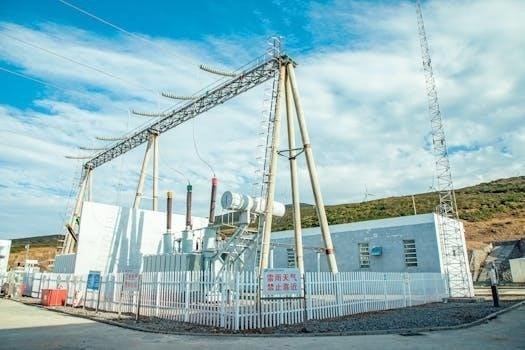Energy transformation worksheets are educational tools designed to help students grasp the concept of energy changing from one form to another. These worksheets often include various examples‚ such as a flashlight transforming chemical energy to light‚ or a toaster converting electrical energy to heat. They are invaluable for classroom learning.
Purpose of Energy Transformation Worksheets
The primary purpose of energy transformation worksheets is to facilitate a deeper understanding of how energy changes form. These worksheets serve as practical tools for students to explore diverse examples of energy conversions‚ such as kinetic to chemical and then electrical to light energy transformations. By engaging with these worksheets‚ students can actively identify and analyze the various types of energy involved in everyday scenarios. They are designed to help students apply their theoretical knowledge by completing practical exercises which enhance retention and comprehension. They encourage critical thinking‚ allowing students to observe‚ analyze‚ and articulate the processes of energy transformation. Through varied exercises‚ these worksheets assist in solidifying understanding‚ making abstract concepts more concrete. Furthermore‚ they are instrumental in preparing students for more advanced scientific concepts related to energy and thermodynamics. The hands-on approach fosters a more intuitive understanding of energy principles. Lastly‚ these worksheets help students improve their problem-solving skills‚ building a strong foundation for further scientific learning and exploration‚ also helping them to visualize difficult concepts.

Key Concepts in Energy Transformation
Energy transformation involves the conversion of energy from one form to another‚ such as kinetic‚ chemical‚ electrical‚ and light. Understanding these conversions is crucial‚ as it is a fundamental principle in physics and everyday life.
Types of Energy Involved in Transformations
Energy transformations involve several key types of energy‚ each with distinct characteristics. Kinetic energy‚ the energy of motion‚ is seen when a car moves or a ball rolls. Potential energy‚ stored energy‚ is evident in a stretched spring or a book on a shelf. Chemical energy‚ stored in molecular bonds‚ is released when fuel burns or food is digested. Electrical energy‚ associated with moving charges‚ powers our homes and devices. Light energy‚ also known as radiant energy‚ is emitted by the sun and light bulbs. Thermal energy‚ related to heat‚ is present in hot objects. Nuclear energy‚ stored in atomic nuclei‚ is released in nuclear reactions. Understanding these forms is key to grasping how energy changes in various systems‚ as they are interconnected‚ and one form can readily change into another. These types are fundamental for analyzing energy transformation in any given scenario.
Examples of Energy Transformation
Numerous everyday scenarios showcase energy transformations. A flashlight‚ for instance‚ converts chemical energy from batteries into electrical energy‚ which then transforms into light energy. An electric saw takes electrical energy and converts it into mechanical energy to cut through materials. A toaster uses electrical energy to produce thermal energy for heating bread. Plants demonstrate a vital transformation by converting radiant energy from the sun into chemical energy during photosynthesis‚ creating food for themselves. Windmills exemplify kinetic energy being transformed into mechanical energy‚ often used to generate electricity. Additionally‚ falling rocks convert potential energy into kinetic energy as they plummet. These examples illustrate how energy is constantly being transformed from one form to another‚ maintaining a dynamic balance. Understanding these examples aids in grasping the versatility and ubiquity of energy transformations in our daily lives and the wider world.

Worksheet Structure and Content
Worksheets on energy transformation typically include sections for student information‚ followed by questions that present different scenarios. These scenarios prompt students to identify the types of energy involved and how they are transformed‚ often using real-world examples.
Typical Questions in Energy Transformation Worksheets
Energy transformation worksheets commonly feature questions that require students to identify energy conversions in various contexts. For instance‚ a question might ask what type of energy transformation occurs when plants use sunlight for photosynthesis‚ where radiant energy is converted into chemical energy. Other questions might present scenarios involving everyday objects like flashlights‚ asking students to trace the energy flow from chemical to electrical to light energy. Furthermore‚ worksheets may include diagrams or pictures‚ challenging students to determine the energy transformations taking place. Some questions are open-ended‚ prompting students to describe the energy changes in their own words‚ rather than just naming the types of energy involved. It is not uncommon to find questions requiring the identification of the key energy-related words or phrases in a given statement. Moreover‚ worksheets might incorporate questions that explore transformations in systems‚ like a windmill or an electric saw‚ requiring students to understand the sequence of energy changes. These questions can also challenge students to analyze more complex scenarios involving multiple steps of energy conversion. The exercises are designed to reinforce understanding of how energy is neither created nor destroyed‚ but rather changes form.
Answer Key Availability and Importance
The availability of an answer key for energy transformation worksheets is crucial for both students and educators. An answer key provides students with immediate feedback on their work‚ enabling them to identify areas where they may need further clarification or study. This self-assessment aspect is particularly beneficial for independent learning and homework assignments. For teachers‚ answer keys are indispensable for efficient grading and assessment‚ allowing for quick and accurate evaluation of student understanding. The answer key also serves as a valuable resource for lesson planning‚ helping teachers identify common misconceptions and adjust teaching strategies accordingly; Furthermore‚ it facilitates a deeper understanding of the subject matter by providing correct answers and explanations‚ which can be used for review and clarification in class. When answer keys are readily available‚ it allows students to learn from their mistakes‚ reinforcing their grasp of the material. The presence of an answer key ensures the worksheet is not just an exercise‚ but also a learning tool‚ providing clear pathways to understanding energy transformations. It is a crucial component for effective teaching and student learning and allows students to not only learn from their mistakes‚ but to quickly grasp the concepts being taught.

Utilizing Energy Transformation Worksheets
These worksheets are beneficial in classrooms to practice identifying energy conversions. They allow students to work through examples and understand how energy changes form. Worksheets can also be used for homework and assessment to reinforce learning.
Classroom Application of Worksheets
Energy transformation worksheets serve as a versatile tool in the classroom‚ facilitating a deeper understanding of how energy changes from one form to another. Teachers can utilize these worksheets in various ways to enhance student learning and engagement. For instance‚ they can be integrated into lesson plans as practice exercises‚ allowing students to apply the concepts they’ve learned in a hands-on manner. These worksheets can also be used for group activities‚ fostering collaboration and peer learning. Students can discuss different energy transformations and complete the worksheet together‚ reinforcing their understanding. Additionally‚ worksheets can be assigned as homework to consolidate classroom learning and identify areas where students might need additional support. Furthermore‚ the worksheets can act as a formative assessment tool‚ enabling teachers to gauge student comprehension and adjust their teaching strategies accordingly. By incorporating real-world examples found in the worksheets‚ students gain a practical understanding of abstract scientific concepts‚ making the subject matter more relatable and memorable. Some worksheets incorporate pictures and diagrams that help visual learners grasp the concepts more effectively. The inclusion of answer keys allows students to self-assess their understanding and correct their mistakes‚ promoting independent learning. The worksheets are also suitable for differentiated learning‚ catering to various learning styles and abilities. They can be modified to suit the needs of individual students or small groups‚ making them an inclusive tool for all learners.

Additional Resources and Tools
To enhance the use of energy transformation worksheets‚ consider utilizing PDF editors for interactive exercises. Online marketplaces also offer a wide array of educational resources‚ including supplemental materials and answer keys‚ to support teaching and learning.
PDF Editors for Interactive Worksheets
PDF editors are incredibly useful tools when working with energy transformation worksheets‚ especially when aiming to create interactive and engaging learning experiences. These editors allow teachers and students to directly modify PDF documents‚ enabling them to fill in answers‚ highlight key concepts‚ and add annotations without needing to print them out. Using a PDF editor‚ one can easily convert static worksheets into dynamic resources. For example‚ students can type their answers directly into the worksheet fields using the editor‚ eliminating the need for handwritten responses and making grading easier. Furthermore‚ these tools often provide options to insert images‚ shapes‚ and arrows‚ which can be used to visually represent energy transformations. Some of these editors‚ like the pdfFiller Google Chrome extension‚ even allow for editing directly from a Google search page‚ making the process very seamless. By incorporating PDF editors‚ educators can create more engaging‚ user-friendly‚ and eco-friendly learning materials while also streamlining the learning process for students by enabling immediate feedback and interaction with the content.
Online Marketplaces for Educational Resources
Online marketplaces have become indispensable resources for educators seeking high-quality educational materials‚ including energy transformation worksheets. These platforms‚ such as Teachers Pay Teachers‚ provide access to a vast collection of original resources created by teachers for teachers. These marketplaces allow educators to find a variety of energy transformation worksheets‚ catering to different grade levels and learning styles. The resources range from basic identification exercises to more complex problem-solving tasks. Many worksheets come with answer keys‚ which are essential for efficient grading and student self-assessment. The ease of accessing these materials through online marketplaces saves educators valuable time and effort in creating their own materials. The availability of diverse resources also allows teachers to customize their teaching approach to meet specific student needs. These online platforms are a valuable tool for obtaining energy transformation worksheets and also offer a way for educators to support one another by sharing their best resources. These marketplaces support educators globally in providing high quality educational tools.
